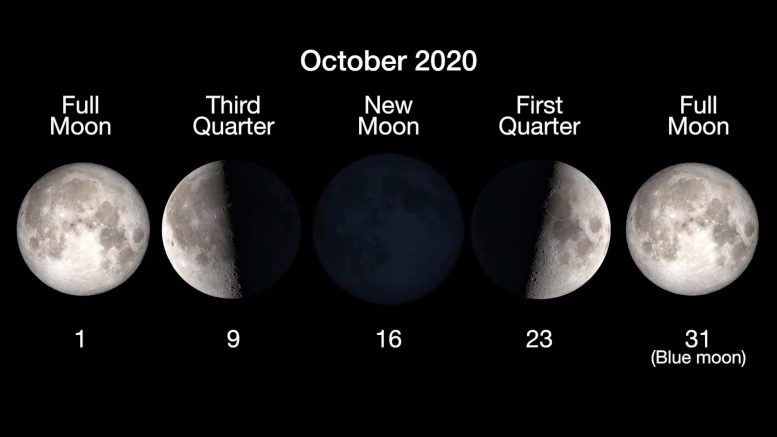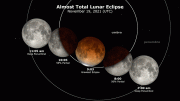What are some skywatching highlights in October 2020? Not one, but two, full Moons; Mars at opposition; and finding the Andromeda galaxy.
Highlights
October is bringing a Harvest Moon AND a Blue Moon, plus look for Mars any time of the night, and go intergalactic with Andromeda!
This month brings not just one, but two full Moons, at the beginning, and at the end of the month. The Harvest Moon – the one that peaked on October 1 – is the name for the full Moon that occurs closest to the September equinox. (One of two days per year when day and night are of equal length.) Most years the Harvest Moon falls in September, but every few years it shifts over to October. The name traces back to both Native American and European traditions related, not surprisingly, to harvest time.
At the end of October, on the 31st, we’ll enjoy a second full Moon. When there are two full Moons in a month, the second is often called a Bue Moon. (There’s another, more traditional definition of a Blue Moon, but this is the most well known.) Note that this is the only two-full-moon month in 2020!
— More about Mars Opposition —
During opposition, Mars and the Sun are on directly opposite sides of Earth. From our perspective on our spinning world, Mars rises in the east just as the Sun sets in the west. Then, after staying up in the sky the entire night, Mars sets in the west just as the Sun rises in the east. Since Mars and the Sun appear on opposite sides of the sky, we say that Mars is in “opposition.”
Oppositions of Mars happen every 26 months. The racetrack model of planetary orbits explains why. Earth and Mars are like runners on a track. Earth is on the inside, Mars is on the outside. Every 26 months, speedy Earth catches up to slower Mars and laps it. Opposition occurs just as Earth takes the lead.
If Earth and Mars followed perfectly circular orbits, opposition would be as close as the two planets could get. But because planetary orbits are elliptical, not all oppositions are the same. An opposition can occur anywhere along Mars’ orbit. Every 15 or 17 years, opposition occurs within a few weeks of Mars’ perihelion (the point in its orbit when it is closest to the Sun). This year, Mars opposition occurs on October 13, 2020.
— More about the Andromeda Galaxy —
At approximately 2.5 million light-years away, the Andromeda galaxy, or M31, is our Milky Way’s largest galactic neighbor. The entire galaxy spans 260,000 light-years across. Andromeda is a spiral galaxy like our own Milky Way, but a bit larger. The light entering your eye when you observe Andromeda left that galaxy 2.5 million years ago when early hominids were just beginning to walk upright here on Earth.
Most of Andromeda’s light comes from its bright central core, which is densely packed with bright stars. Thus it appears as a faint, fuzzy patch on the sky with a somewhat brighter spot near the center. Because it’s somewhat faint, binoculars or a telescope are recommended, and it’s best viewed on nights without a bright Moon.
Daily Guide
October 2-3
On the mornings of Friday and Saturday, October 2 and 3, 2020, the bright planet Venus and the bright star Regulus will appear at their closest in the eastern sky, rising in the east-northeast around 3:50 a.m. EDT (for the Washington, DC area) and appearing about 26 degrees above the eastern horizon at the time morning twilight begins (at around 6:08 AM).
On Friday evening into Saturday morning, October 2 to 3, 2020, the planet Mars will appear near the full Moon. For the Washington, D.C. area, they will appear about 2 degrees above the horizon in the east as evening twilight ends on Friday evening at 7:46 p.m. EDT (with Mars on the left), they will appear near their closest to each other a little before midnight (with Mars above the Moon), the Moon will reach its highest in the sky for the night on Saturday morning at 1:59 a.m. (with Mars to the upper right), and they will appear about 25 degrees above the horizon in the west-southwest as morning twilight begins at 6:09 AM. If you happen to be in the South Atlantic or in the southern tip of South America, the Moon will pass in front of Mars.
Saturday, October 3, 2020, at 1:23 p.m. EDT, the Moon will be at apogee, its farthest from the Earth for this orbit.
October 6-7
On Tuesday night into Wednesday morning October 6 to 7, 2020, the bright star Aldebaran will appear to the lower right of the waning gibbous Moon. For the Washington, DC area, Aldebaran will rise after the Moon in the east-northeast at 9:42 p.m. EDT, the Moon will reach its highest in the sky for the night on Wednesday morning at 4:55 AM, and morning twilight will begin around 6:13 AM.
October 8
On Thursday morning, October 8, 2020, at around 7:16 a.m. EDT (2020-Oct-08 11:16 UTC with 13 minutes uncertainty), Near Earth Object (2020 SX3), between 38 and 86 meters (126 to 282 feet) across, will pass the Earth at 4.4 lunar distances traveling at 10.88 kilometers per second (24,340 miles per hour).
October 9-10
On Friday evening, October 9, 2020, the waning Moon will appear half-full as it reaches its last quarter at 8:40 p.m. EDT.
Late Friday night into Saturday morning, October 9 to 10, 2020, the bright star Pollux (one of the twins in the constellation Gemini) will appear to the left of the waning half-moon. For the Washington, DC area, the pair will rise in the east-northeast Friday night at about 11:52 p.m. EDT and morning twilight will begin Saturday morning at 6:15 AM.
October 12
On Tuesday morning, October 13, 2020, the bright star Regulus will appear about 6 degrees to the right of the waning crescent Moon. For the Washington, DC area, the Moon will rise in the east-northeast at 3:09 a.m. EDT and morning twilight will begin around 6:18 AM.
On Tuesday evening, October 13, 2020, the planet Mars will be at its brightest and closest to Earth for this apparition, appearing opposite the Sun as seen from Earth (called opposition, effectively a “full” Mars).
October 14
On Wednesday morning, October 14, 2020, the bright planet Venus will appear to the upper right of the waning crescent Moon. For the Washington, DC area, the Moon will rise in the east-northeast at 4:22 a.m. EDT and morning twilight will begin around 6:19 AM.
October 16
Friday afternoon, October 16, 2020, at 3:31 p.m. EDT, will be the new Moon, when the Moon will pass between Earth and the Sun and will not be visible from Earth. About 4 hours later, at 7:47 p.m. EDT, the Moon will be at perigee, its closest to Earth for this orbit. Since this new Moon is near perigee, it is a “Supermoon” as designated by the astrologer Richard Nolle, who is credited with introducing the term. However, most of the public interest is in full Supermoons we can see, not in new Supermoons, we cannot see.
October 17-20
The day of, or the day after, the New Moon typically marks the start of the new month for most lunar and lunisolar calendars. The ninth month of the Chinese calendar starts on October 17 (at midnight in China’s time zone, which is 12 hours ahead of EDT). In the Islamic calendar, the months traditionally start with the first sighting of the waxing crescent Moon after the New Moon, although many Muslim communities now follow the Umm al-Qura Calendar of Saudi Arabia, which uses astronomical calculations to start months in a more predictable way. Using this calendar Rabī’ al-Awwal (the third month of the year) will begin at sunset on Saturday, October 17, 2020. Most Muslims celebrate the birthday of the Prophet Muhammad during this month although Sunni and Shi’a Muslims disagree on the exact date. Sundown on October 18, 2020, also marks the start of Marcheshvan in the Hebrew calendar. In the Burmese lunar calendar October 17, 2020, marks the first Waxing Moon day of the month of Thadingyut. The Buddhist Hpaung Daw U Festival starts on this day and ends 18 days later, a few days past the next full Moon (on November 3, 2020). In the Hindu lunar calendar, October 17 marks the start of the month of Ashwin, which starts with the 9-day post-monsoon harvest festival called Sharada Navaratri.
If (and it is a big if) the Comet C/2020 P1 (NEOWISE) is going to be visible in the predawn sky, the morning of Sunday, October 18, 2020, might be the best time to look for it. This will be the first morning that it will be (barely) above the horizon in the east as morning twilight begins (at 6:23 a.m. EDT for the Washington, DC area). This comet will be moving closer to the Sun, which means it will be getting brighter as it gets more sunlight to reflect towards Earth, while it will also be moving away from Earth (making it dimmer). Based just on geometry (square of the distance from the Sun to the comet times the square of the distance from the comet to Earth), it would be at its brightest the morning before (but will not rise until about 11 minutes after morning twilight begins). It would still be at 99 percent of this brightness when it rises on October 18. By October 19 it will be 1.9 degrees higher in the sky but would be at 96 percent of this maximum brightness. By October 20 it will be another 1.7 degrees higher but at 91 percent of this maximum. The brightness would drop off faster each morning after this as it moves away from both the Sun and Earth (but gets higher in the morning sky).
On Monday evening, October 19, 2020, the bright star Antares will appear about 5 degrees below the waxing crescent Moon. As evening twilight ends (at 7:21 p.m. EDT for the Washington DC area), The Moon will be about 11.5 degrees above and Antares about 7 degrees above the horizon in the southwest. Antares will set at 8:07 p.m. and the Moon will set in the west-southwest at 8:41 PM.
October 21
As mentioned in the introduction above, the Orionid Meteor Shower is expected to peak early in the morning of Wednesday, October 21, 2020. The expected peak (under ideal conditions) is about 20 visible meteors per hour. However, according to the International Meteor Organization, the strength of this shower has been varying from year to year and sometimes has several peaks across several days near the expected peak. In addition, there is some evidence that a larger than usual peak may occur sometime between 2020 and 2022. The best time to look for these meteors would be after midnight but before the sky begins to lighten with the dawn. Ideal conditions would be clear skies with no haze or clouds, a clear view of a large part of the sky after midnight, and a location far from any lights or urban light pollution. You will need to be patient (20 meteors per hour means on average a visible meteor every 3 minutes or so) and give your eyes plenty of time to adapt to the dark (it can take more than 45 minutes for your eyes to adapt fully to night vision, so no turning on lights or your smartphone to check the time). Those of us living close to city lights will have much less of a chance of seeing these meteors.
October 22
On Thursday evening, October 22, 2020, the nearly half-full waxing Moon, the bright planet Jupiter, and the fainter planet Saturn, will form a triangle in the southern sky with Jupiter to the right and Saturn above. As evening twilight ends (at 7:17 p.m. EDT for the Washington DC area), the Moon will appear 25 degrees above the southern horizon. Jupiter will set first in the west-southwest at 11:12 PM, the Moon next at 11:26 PM and Saturn last at 11:41 PM.
October 23
On Friday morning, October 23, 2020, the Moon will appear half-full as it reaches its first quarter at 9:23 a.m. EDT.
October 25
On Sunday, October 25, 2020, the planet Mercury will be passing between Earth and the Sun as seen from Earth called inferior conjunction. Mercury will be shifting from the evening sky to the morning sky and will begin emerging from the glow of dawn on the eastern horizon about four mornings later (depending upon viewing conditions).
October 29-30
Thursday morning, October 29, 2020, will be the first morning that the planet Mercury will be above the horizon in the east-southeast 30 minutes before sunrise (an approximation of when it might first be visible in the glow of dawn).
Thursday night, October 29, 2020, is the second of the two Japanese Tsukimi or “Moon-Viewing” festivals, which takes place on the 13th day of the lunar month and celebrates the viewing of the waxing gibbous Moon a few days before it is full.
On Thursday night into Friday morning, October 29 to 30, 2020, the bright planet Mars will appear near the nearly full waxing Moon. As evening twilight ends (at 7:09 p.m. EDT for the Washington, DC area), the Moon will appear about 17 degrees above the eastern horizon, with Mars appearing above the Moon. The Moon will reach its highest in the sky for the night around midnight with Mars to the right. Mars will set first in the west on Friday morning at 5:54 AM, with the Moon setting at 6:27 AM, just a little before morning twilight begins.
Friday afternoon, October 30, 2020, at 2:46 p.m. EDT, the Moon will be at apogee, its farthest from the Earth for this orbit.
Sometime between Friday, October 30, 2020, and Thursday, November 5, 2020, Near Earth Object (2018 VP1), between 2 and 4 meters (6 to 13 feet) in size will most likely pass the Earth somewhere between 0.02 and 10.0 lunar distances (nominally 1.1), traveling at 9.71 kilometers per second (21,720 miles per hour). Nominally the closest approach would be on November 2, 2020, at 11:33 UTC but this has 3 days, 7 hours, 11 minutes uncertainty due to the lack of observations on such a small object. This object could have a 0.41% or 1 in 240 chance of entering the Earth’s atmosphere on November 2, 2020, most likely over the Pacific Ocean if it did. An object this size would break up harmlessly high above the surface with only small pieces falling as debris after the breakup. The mass of this object is estimated to be between 100 and 1,000 times less than the approximately 20 m (66 ft) object that entered the Earth’s atmosphere over Chelyabinsk, Russia, in 2013.
October 31 – The Next Full Moon
The full Moon after next will occur on the morning of Halloween, Saturday, October 31, 2020. We currently divide the year into four seasons based upon the solstices and equinoxes, with winter beginning on the winter solstice in December. This approximates winter as the quarter of the year with the coldest temperatures. Much of pre-Christian northern Europe celebrated “cross-quarter days” halfway between the solstices and equinoxes, and divided the seasons on these days. Using this older definition, winter was the quarter of the year with the shortest daily periods of daylight, with autumn ending and winter beginning with Samhain, traditionally celebrated on October 31st or November 1st (the middle of our fall). Our Halloween customs are thought to have come from these earlier celebrations of the end of fall and start of winter.










Be the first to comment on "October 2020 Skywatching Tips From NASA: Harvest Moon, Blue Moon, Mars, and Go Intergalactic With Andromeda"